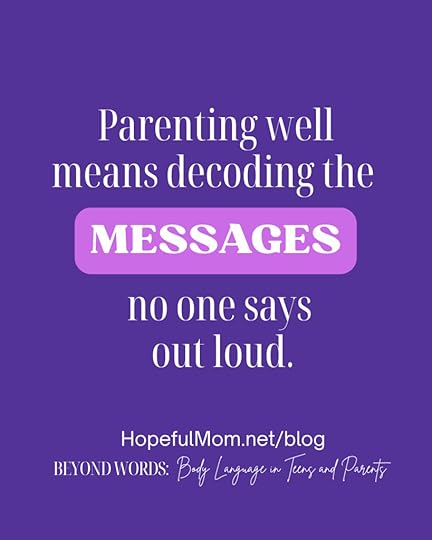Beyond Words: Body Language in Teens and Parents
Body language is a crucial element to communication–especially when parenting teens. (See end of post for an upcoming event.)
“Do you need a minute?” I asked my daughter. I saw she was upset and on the verge of tears. She struggled to articulate her problem and the emotions it evoked.
“Yes.” Her shoulders relaxed, and the tears flowed.
I put my arm around her and waited quietly. I knew from experience that sitting with her while she cried would help her work through her emotions and communicate more effectively.
After a few minutes, it all came tumbling out. Her car was acting up again, and she’d nearly been in an accident. A valid reason for the emotional turmoil.
A day later the car was fixed, and my daughter’s emotions were normalized. I’m grateful I’d been available, sensed her need, and responded appropriately.
Constant Communication“We send and receive messages all day: a look, a sound, a gesture, the way we walk, the way we pause mid-sentence, the way our voices rise and fall, a text, a post, a note, laughing, crying, smiling, frowning. These are all messages. Whether intentional or unintentional, whether perceived or real, we transmit ideas and opinions throughout the day to those in our vicinity.” (excerpt from Sexpectations: Helping the Next Generation Navigate Healthy Relationships, p. 120)
Body Language“A high percentage of messages are communicated through body language. We lean in when we’re engaged. We back up when we’re disinterested or afraid. We tower over someone to show power and lower ourselves to show equality. Toddlers poke their parents to get their attention. Teens bat their eyes or flip their hair to flirt. They strut their stuff in confidence or slouch and hang their heads when feeling unnoticed, insecure, or ashamed.” (excerpt from Sexpectations p. 129)

Parenting well means decoding the messages no one says out loud. Our job requires awareness of our body language, as well as interpreting our children’s signals. Not an easy task, yet one that’s necessary to build trust and nurture healthy relationships.
Maybe a child’s overreaction or lack of concern baffles you. Their response seems out of sync with the situation.
And yet, I too sometimes send mixed signals, and others misinterpret my body language.
My face is descriptive. Easily read. Others can tell if I’m annoyed, frustrated, bored, or agitated. And they react to my signal. Unfortunately, misreadings can instigate improper responses. For example, if my child misinterprets my concentration face as, “I’m mad at you,” or “I’m not listening to you,” they may feel devalued. That’s a message I never want to send.
Reading body language becomes especially challenging during tense situations or difficult conversations. I’m careful to check myself. Does my body language invite openness rather than show contempt? Is my facial expression one of curiosity and concern rather than judgment? Am I providing a quiet space for my child to think about her responses?
Our SignalsSometimes my body language reflects my intense feelings—anger, hurt, fear—but I don’t want that emotion to interfere with the conversation. When I sense my child is reacting to one of these signals, I address it.
“I am angry right now, but I still love you. My response to this situation will not be based on anger.” (I may need a cooling-off period before continuing the conversation.)“I am deeply hurt, but I realize you didn’t intentionally hurt me. I will recover, and whatever decisions we make regarding this problem won’t be based on me or my feelings. I love you, and it’s my job to protect you, and I will do my best to do that.” (I may need a time-out to forgive and get past my hurt.)“I am afraid something terrible may happen, but we won’t make a decision based on fear.”To show teens we value their thoughts and feelings, use positive cues: nods, eye contact, open posture (uncrossed arms, relaxed shoulders), smiles, and appropriate touch.
Our gestures teach. Their signals speak. Stay tuned in.Teens send signals! Blank stares, rolled eyes, slammed doors, silence, angry tears, crossed arms, tight jaws, clenched fists.
Teens send signals! So do parents. Our gestures teach. Their signals speak. Stay tuned in. Beyond Words: Body Language in Teens and Parents #bodylanguage #hopefulmom #difficultconversations
Share on X
It’s easy to react to their behavior; however, not allowing their attitude or conduct to affect ours is important. Sometimes they truly don’t know what they think or feel, and they’re doing their best to communicate without having a meltdown. A tantrum could be a cry for help. Procrastination could be a clue that they don’t know how to proceed. A quick, “I DON’T KNOW” may really mean they truly don’t know.
Let’s try to look beyond the behavior, past the body language, and into the core of who they are to detect the actual message. And when all else fails, ask open-ended questions, sit quietly, and listen. Sometimes all they need is someone to put their arm around them and offer them time and space to process their emotions.

Barb is speaking at a ladies event on August 23rd at Hope Community Church in Wildwood, FL. I invite you to join us! See details here: When God Plants Seeds: Faith in the Valley.
Have you read Sexpectations: Helping the Next Generation Navigate Healthy Relationships? Please write a review at Amazon and/or Goodreads. Reviews, especially 5-star reviews, are how word spreads about this resource. Thanks so much!
The post Beyond Words: Body Language in Teens and Parents appeared first on HOPEFUL MOM.



